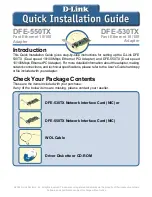
To configure a profile with WPA-Personal network authentication and TKIP data encryption:
1. On the Intel PROSet/Wireless main window, double-click an Infrastructure network in the Wireless
Networks list or select the network and click
Connect
.
2. Click
Profiles
to access the Profiles list.
3. Click
Properties
to open the Wireless Profile Properties' General Settings. The Profile name and Wireless
Network Name (SSID) display.
Network (Infrastructure)
should be selected as the Operating Mode.
4. Click
Next
to access the Security Settings.
5.
Security Settings:
Select
WPA-Personal (TKIP)
to provide security to a small business network or
home environment. A password, called a pre-shared key (PSK), is used. The longer the password, the
stronger the security of the wireless network.
If your wireless access point or router supports WPA2-Personal then you should enable it on the
access point and provide a long, strong password. The longer the password, the stronger the
security of the wireless network. The same password entered in the access point needs to be used
on this computer and all other wireless devices that access the wireless network.
NOTE:
WPA-Personal and WPA2-Personal are not interoperable.
6.
Wireless Security Password (Encryption Key):
Enter a text phrase with eight to 63 characters.
Verify that the network key matches the password in the wireless access point.
7. Click
OK
to return to the Profiles list.
Set up a Client with WPA-Personal (AES-CCMP) or WPA2-Personal (AES-CCMP)
Security Settings
Wi-Fi Protected Access (WPA) is a security enhancement that strongly increases the level of data protection
and access control to a wireless network. WPA enforces 802.1x authentication and key-exchange and only
works with dynamic encryption keys. For a home user or small business, WPA-Personal utilizes either Advanced
Encryption Standard - Counter CBC-MAC Protocol (AES-CCMP) or Temporal Key Integrity Protocol (TKIP).
To configure a profile with WPA2-Personal network authentication and AES-CCMP data encryption:
1. On the Profile page, select a profile.
2. Click
Properties
to open the Wireless Profile Properties' General Settings. The Profile name and Wireless
Network Name (SSID) display. Network (Infrastructure) should be selected as the Operating Mode.
3. Click
Next
. The Security Settings page opens.
4.
Security Settings:
Select
WPA-Personal (AES-CCMP)
to provide this level of security in the small
network or home environment. It uses a password also called a pre-shared key (PSK). The longer the
password, the stronger the security of the wireless network.
AES-CCMP
(Advanced Encryption Standard - Counter CBC-MAC Protocol) is the new method for
privacy protection of wireless transmissions specified in the IEEE 802.11i standard. AES-CCMP
provides a stronger encryption method than TKIP. Choose AES-CCMP as the data encryption
method whenever strong data protection is important.
If your Wireless access point or router supports WPA2-Personal then you should enable it on the
access point and provide a long, strong password. The same password entered into access point
needs to be used on this computer and all other wireless devices that access the wireless network.
NOTE:
WPA-Personal and WPA2-Personal are not interoperable.
Some security solutions may not be supported by your computer's operating system. You may
require additional software or hardware as well as wireless LAN infrastructure support. Contact
your computer manufacturer for details.
Summary of Contents for Wireless WiFi Link 4965AGN
Page 31: ...Back to Top Back to Contents Trademarks and Disclaimers ...
Page 36: ...Back to Top Back to Contents Trademarks and Disclaimers ...
Page 144: ...Back to Contents Trademarks and Disclaimers ...
Page 152: ...Back to Top Back to Contents Trademarks and Disclaimers ...
Page 174: ......
Page 175: ......
Page 183: ......
















































